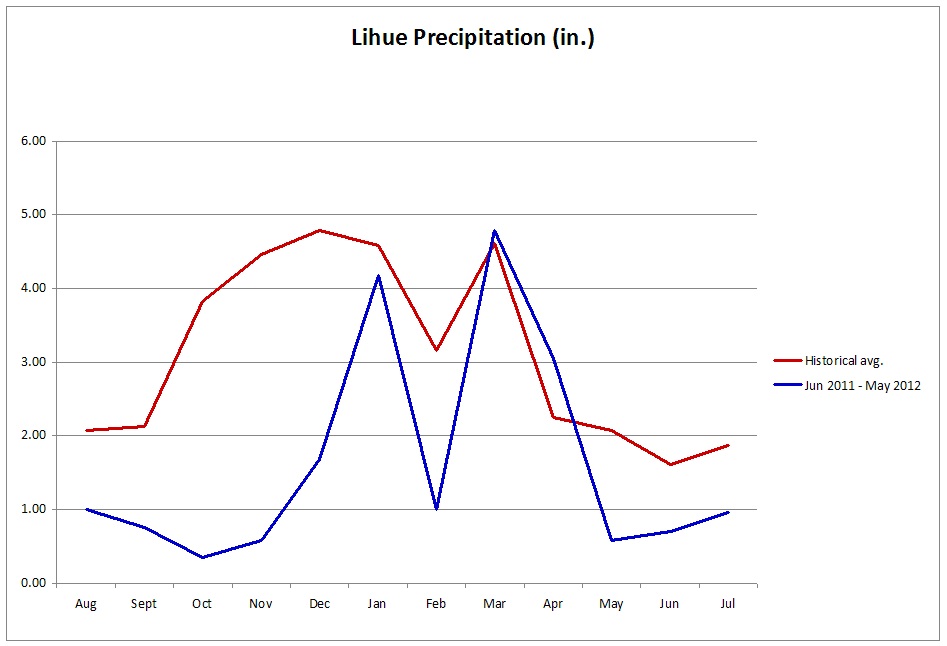Monthly Climate and Impacts Report for Hawaii - July 2013
Chris O'Connor and Dr. Pao-Shin Chu
Hawaii State Climate Office
Department of Meteorology
University of Hawaii
Honolulu, HI 96822
Precipitation and Temperature
Winter and spring seasons brought improving rainfall trends to most of the state of Hawai'i. However the first two months of summer has taken a step backwards from the former improving rainfall trends. All of the Hawaiian islands experienced about half of the normal precipitation amounts, except for the island of Maui. Maui saw wetter than normal conditions (~172% of normal) for the third straight month in a row, and for the sixth month in the last eight. Interesting to note, Maui received almost all of its rainfall this month in a period of two days when a tropical storm/depression (Flossie) passed through the state. The other islands were not so fortunate. Hilo experienced less than normal rainfall (39.69% of normal) for the fifth month in a row. Hilo has been the getting hit the hardest with precipitation deficiency, seeing less than normal rainfall ten out of the past twelve months. Honolulu experienced below average precipitation (68.63% of normal) for the second month in a row and for the ninth month over the past year. Similarly, Kauai pulled in well below average rainfall amounts, as Lihue saw 51.34% normal rainfall and below average precipitation for the third month in a row. This is in contrast to above average rainfall in Kauai the first two months of spring. With an overall state-wide decrease of precipitation in July, drought conditions in the state have worsened for the first time since Fall 2012. Both Oahu and Kauai have deteriorated from complete drought free condition. Southwest sectors of both islands are "abnormally dry". The eastern islands have experienced a slight increase in drought this month, while there are still areas of drought in this part of the state ranging from "Abnormally Dry" (D0) to "Extreme Drought" (D3) on a scale of D0-D4. The big picture: besides Tropical storm Flossie, July was abnormally dry.
Temperature anomalies were very interesting this month. Temperature regimes can be split into two sections: eastern and western islands. In the eastern Hawaiian islands, the mean temperatures as well as mean highs were above their respective historical averages, while mean lows were below their respective historical averages. In the western Hawaiian islands, the mean temperatures as well as mean highs and mean lows were below their respective historical averages.
The NOAA Climate Prediction Center seasonal outlook for Hawaii predicted equal chances for above, near, and below normal temperatures for the Hawaiian Islands in August 2013. Below median precipitation amounts are favored for Hawaii in August 2013 according to a majority of climate models.
ENSO
During July 2013 ENSO-neutral continued. Equatorial sea surface temperatures (SST) are near average across the western and central Pacific Ocean and below average across the eastern Pacific. ENSO-neutral is favored into the Northern Hemisphere fall 2013.
Impacts
July 2013 brought a very unique system to the state of Hawaii, tropical storm Flossie. Much anticipation, preparation, and excitement came with this weather phenomenon. Hawaii does not often experience the impact of a tropical storm or hurricane. Flossie prompted school and court closures and an emergency declaration from Gov. Neil Abercrombie before hitting shore. after surfers caught waves on the Big Island and tourists sunbathed despite showers and overcast skies in Waikiki, Flossie made its mark on the state Monday July 29th with widespread thunder and lightning, heavy rain and winds that knocked out power to thousands on several islands. Maui County officials said that widespread power outages were affecting water service on many parts of Maui and Molokai, with no estimate of when power will be restored. Winds and rainfall from the faltering system earlier knocked out power for about 6,500 people on Maui and the Big Island. On Oahu, rolling thunder rumbled across the most populous island in the state. Warnings about the storm didn't stop some tourists from heading to popular beaches, despite urgings from state officials to cancel all beach trips until further notice. In Waikiki, beaches were unusually sparse as those outside contended with overcast skies and rain ahead of Flossie's arrival.
As mentioned above, Maui was the only island in the state with above average rainfall this month. Interestingly, most all of the rainfall came on one day due to Flossie. On Tuesday July 30th, a record 0.79 inches of rainfall fell at Kahului, breaking the old record of 0.35 inches set in 1967.








